ITECH7400: ITSM and Professional Culture Report for University
VerifiedAdded on 2023/01/19
|11
|1839
|51
Report
AI Summary
This report delves into the realm of IT Service Management (ITSM), examining its core principles and practical applications within an organization. The report begins with an abstract defining ITSM as a collection of IT management processes designed to deliver effective IT-based services, emphasizing its role in aligning IT services with business needs and enhancing customer satisfaction. The discussion covers key issues in ITSM, such as customer experience management and staff management. It then explores the role of ITSM in the Department of Education and Training of HP, highlighting its benefits in cost minimization and efficiency improvements. The report further examines how ITSM enhances business functions through incident, change, and knowledge management, and outlines the five key ITSM processes based on the ITIL framework: service strategy, service design, service transition, service operation, and continual service improvement. The report concludes by emphasizing the importance of ITSM in organizations, highlighting its role in customer satisfaction, reducing delivery time, and providing effective service support. The report provides a valuable overview of ITSM and its impact on business operations. This report is available on Desklib, a platform providing students with AI-based study tools, past papers, and solved assignments.
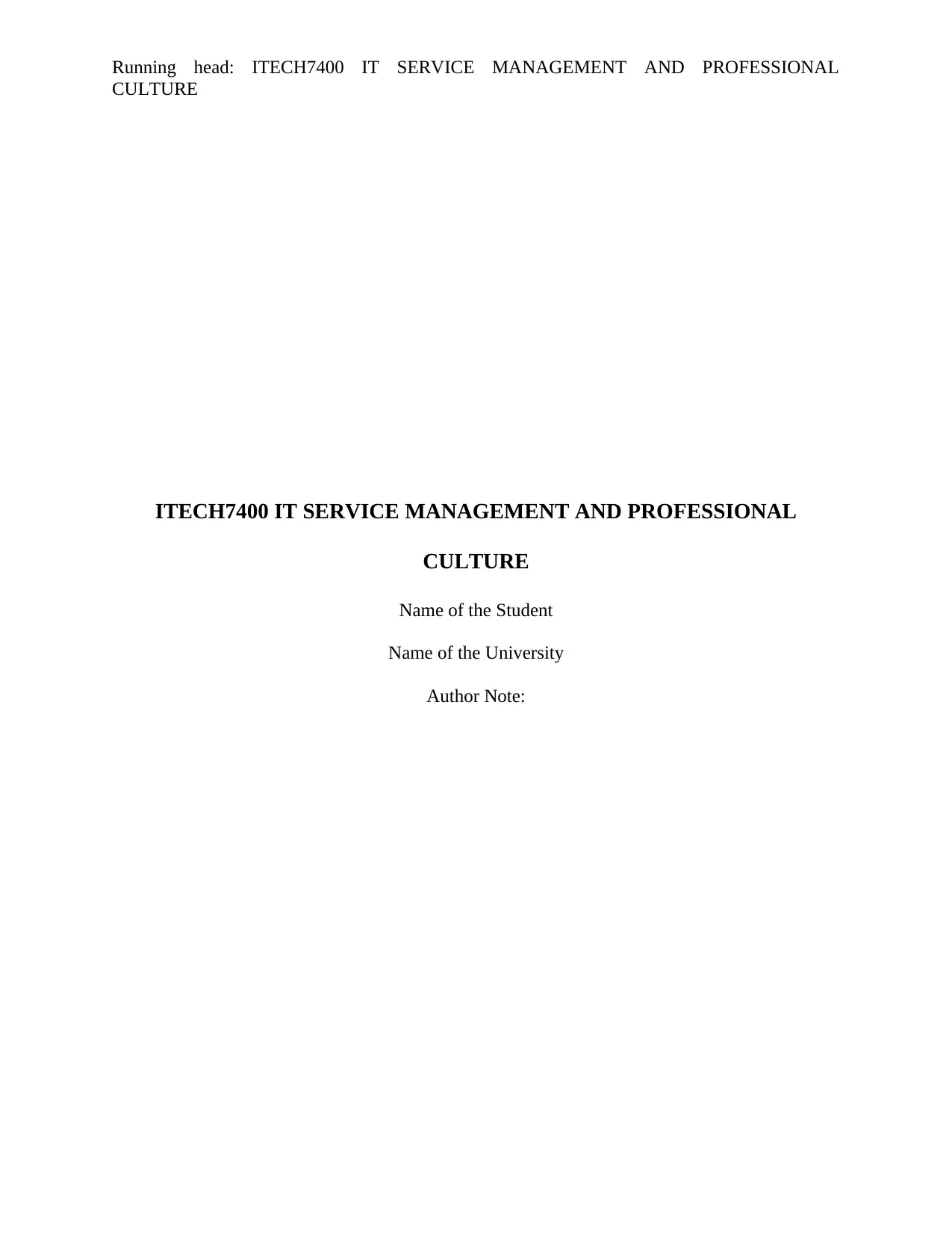
Running head: ITECH7400 IT SERVICE MANAGEMENT AND PROFESSIONAL
CULTURE
ITECH7400 IT SERVICE MANAGEMENT AND PROFESSIONAL
CULTURE
Name of the Student
Name of the University
Author Note:
CULTURE
ITECH7400 IT SERVICE MANAGEMENT AND PROFESSIONAL
CULTURE
Name of the Student
Name of the University
Author Note:
Paraphrase This Document
Need a fresh take? Get an instant paraphrase of this document with our AI Paraphraser
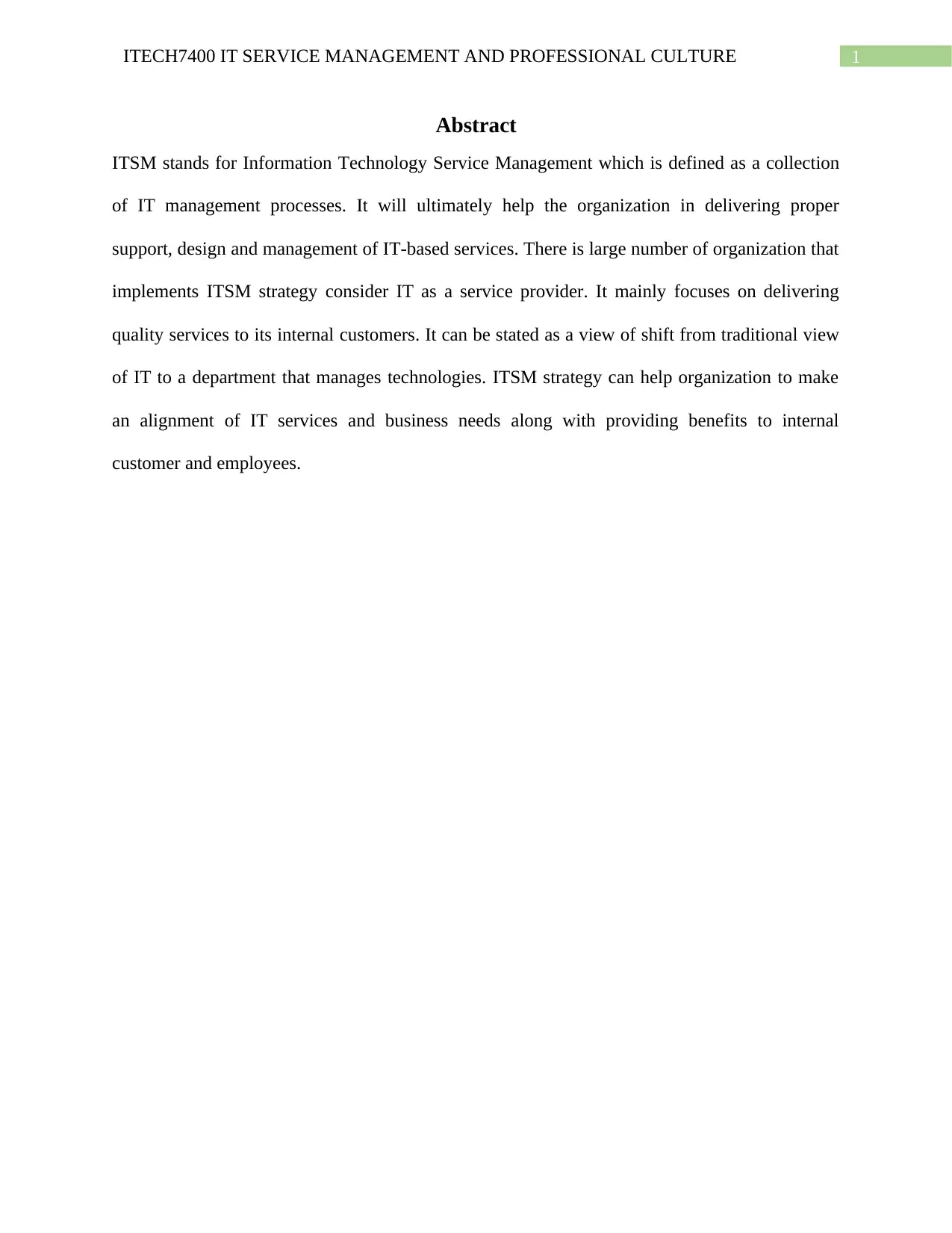
1ITECH7400 IT SERVICE MANAGEMENT AND PROFESSIONAL CULTURE
Abstract
ITSM stands for Information Technology Service Management which is defined as a collection
of IT management processes. It will ultimately help the organization in delivering proper
support, design and management of IT-based services. There is large number of organization that
implements ITSM strategy consider IT as a service provider. It mainly focuses on delivering
quality services to its internal customers. It can be stated as a view of shift from traditional view
of IT to a department that manages technologies. ITSM strategy can help organization to make
an alignment of IT services and business needs along with providing benefits to internal
customer and employees.
Abstract
ITSM stands for Information Technology Service Management which is defined as a collection
of IT management processes. It will ultimately help the organization in delivering proper
support, design and management of IT-based services. There is large number of organization that
implements ITSM strategy consider IT as a service provider. It mainly focuses on delivering
quality services to its internal customers. It can be stated as a view of shift from traditional view
of IT to a department that manages technologies. ITSM strategy can help organization to make
an alignment of IT services and business needs along with providing benefits to internal
customer and employees.
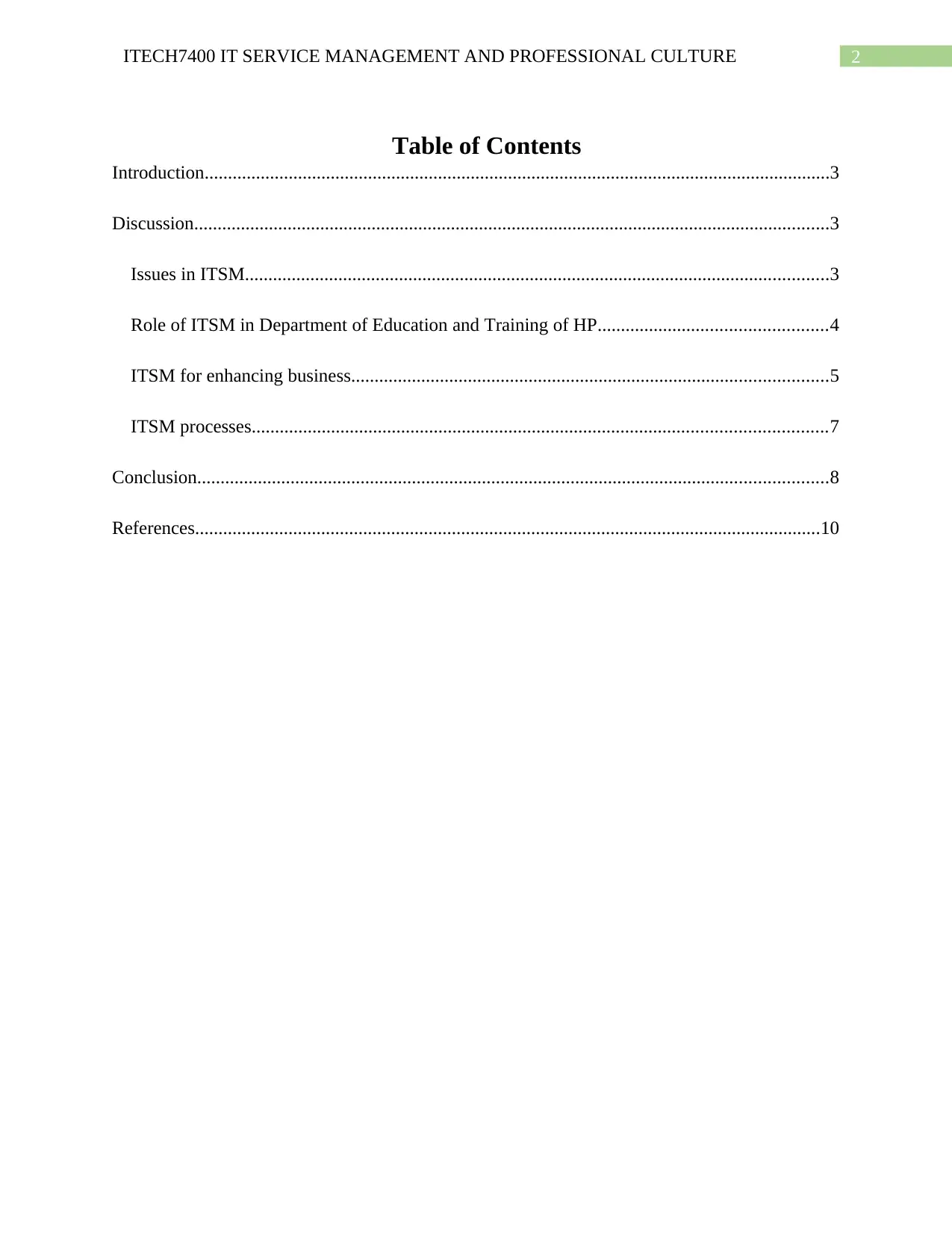
2ITECH7400 IT SERVICE MANAGEMENT AND PROFESSIONAL CULTURE
Table of Contents
Introduction......................................................................................................................................3
Discussion........................................................................................................................................3
Issues in ITSM.............................................................................................................................3
Role of ITSM in Department of Education and Training of HP.................................................4
ITSM for enhancing business......................................................................................................5
ITSM processes...........................................................................................................................7
Conclusion.......................................................................................................................................8
References......................................................................................................................................10
Table of Contents
Introduction......................................................................................................................................3
Discussion........................................................................................................................................3
Issues in ITSM.............................................................................................................................3
Role of ITSM in Department of Education and Training of HP.................................................4
ITSM for enhancing business......................................................................................................5
ITSM processes...........................................................................................................................7
Conclusion.......................................................................................................................................8
References......................................................................................................................................10
⊘ This is a preview!⊘
Do you want full access?
Subscribe today to unlock all pages.

Trusted by 1+ million students worldwide
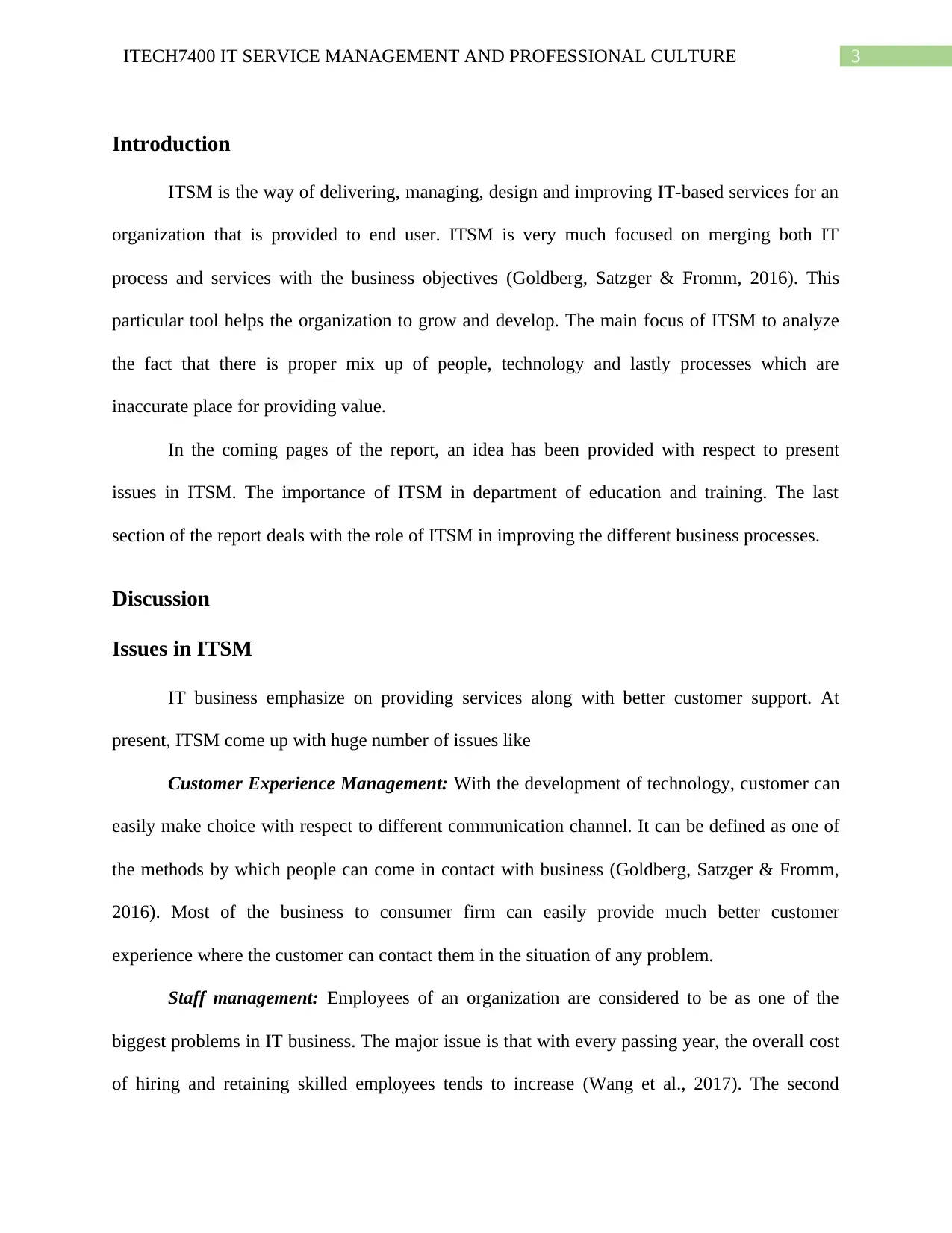
3ITECH7400 IT SERVICE MANAGEMENT AND PROFESSIONAL CULTURE
Introduction
ITSM is the way of delivering, managing, design and improving IT-based services for an
organization that is provided to end user. ITSM is very much focused on merging both IT
process and services with the business objectives (Goldberg, Satzger & Fromm, 2016). This
particular tool helps the organization to grow and develop. The main focus of ITSM to analyze
the fact that there is proper mix up of people, technology and lastly processes which are
inaccurate place for providing value.
In the coming pages of the report, an idea has been provided with respect to present
issues in ITSM. The importance of ITSM in department of education and training. The last
section of the report deals with the role of ITSM in improving the different business processes.
Discussion
Issues in ITSM
IT business emphasize on providing services along with better customer support. At
present, ITSM come up with huge number of issues like
Customer Experience Management: With the development of technology, customer can
easily make choice with respect to different communication channel. It can be defined as one of
the methods by which people can come in contact with business (Goldberg, Satzger & Fromm,
2016). Most of the business to consumer firm can easily provide much better customer
experience where the customer can contact them in the situation of any problem.
Staff management: Employees of an organization are considered to be as one of the
biggest problems in IT business. The major issue is that with every passing year, the overall cost
of hiring and retaining skilled employees tends to increase (Wang et al., 2017). The second
Introduction
ITSM is the way of delivering, managing, design and improving IT-based services for an
organization that is provided to end user. ITSM is very much focused on merging both IT
process and services with the business objectives (Goldberg, Satzger & Fromm, 2016). This
particular tool helps the organization to grow and develop. The main focus of ITSM to analyze
the fact that there is proper mix up of people, technology and lastly processes which are
inaccurate place for providing value.
In the coming pages of the report, an idea has been provided with respect to present
issues in ITSM. The importance of ITSM in department of education and training. The last
section of the report deals with the role of ITSM in improving the different business processes.
Discussion
Issues in ITSM
IT business emphasize on providing services along with better customer support. At
present, ITSM come up with huge number of issues like
Customer Experience Management: With the development of technology, customer can
easily make choice with respect to different communication channel. It can be defined as one of
the methods by which people can come in contact with business (Goldberg, Satzger & Fromm,
2016). Most of the business to consumer firm can easily provide much better customer
experience where the customer can contact them in the situation of any problem.
Staff management: Employees of an organization are considered to be as one of the
biggest problems in IT business. The major issue is that with every passing year, the overall cost
of hiring and retaining skilled employees tends to increase (Wang et al., 2017). The second
Paraphrase This Document
Need a fresh take? Get an instant paraphrase of this document with our AI Paraphraser
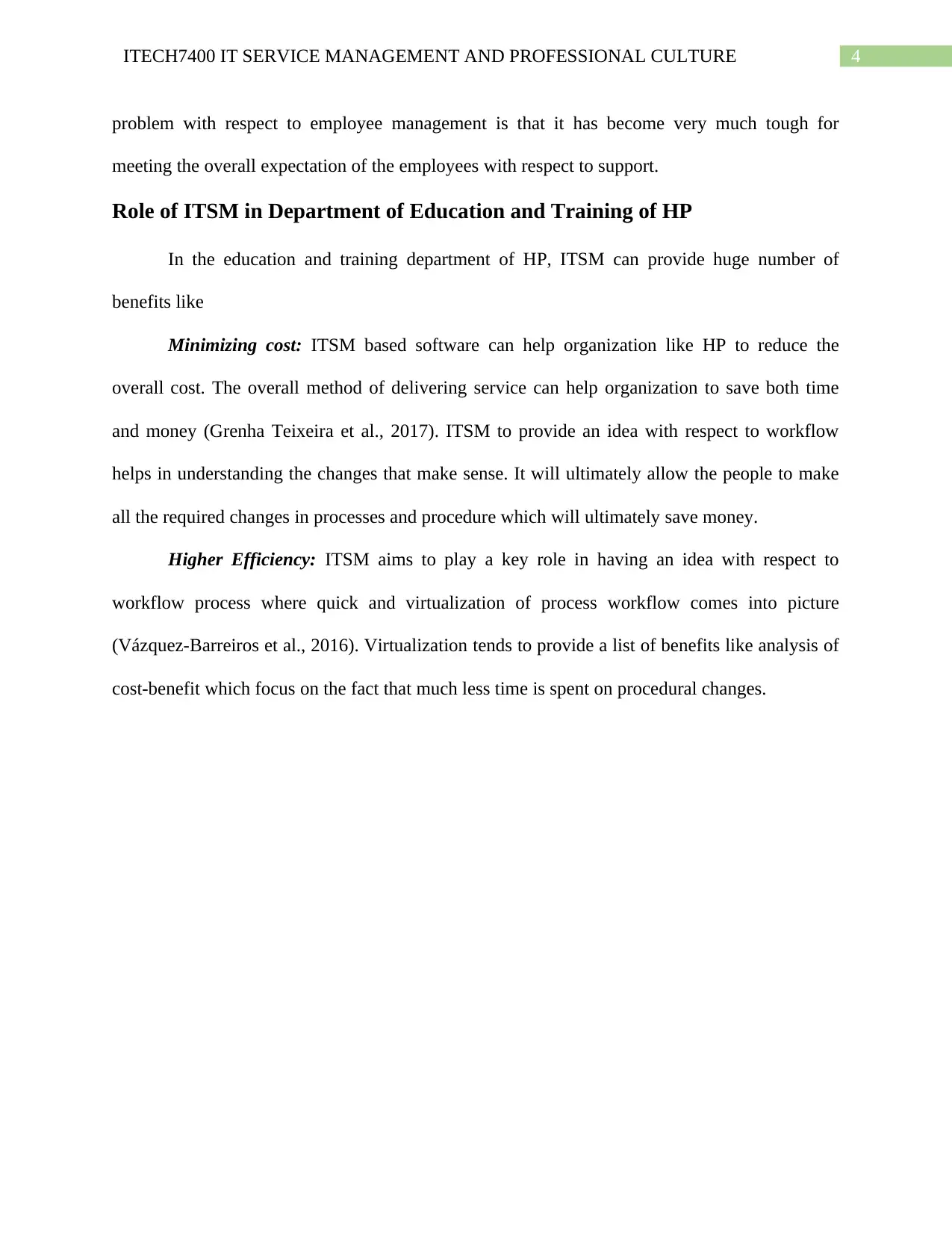
4ITECH7400 IT SERVICE MANAGEMENT AND PROFESSIONAL CULTURE
problem with respect to employee management is that it has become very much tough for
meeting the overall expectation of the employees with respect to support.
Role of ITSM in Department of Education and Training of HP
In the education and training department of HP, ITSM can provide huge number of
benefits like
Minimizing cost: ITSM based software can help organization like HP to reduce the
overall cost. The overall method of delivering service can help organization to save both time
and money (Grenha Teixeira et al., 2017). ITSM to provide an idea with respect to workflow
helps in understanding the changes that make sense. It will ultimately allow the people to make
all the required changes in processes and procedure which will ultimately save money.
Higher Efficiency: ITSM aims to play a key role in having an idea with respect to
workflow process where quick and virtualization of process workflow comes into picture
(Vázquez-Barreiros et al., 2016). Virtualization tends to provide a list of benefits like analysis of
cost-benefit which focus on the fact that much less time is spent on procedural changes.
problem with respect to employee management is that it has become very much tough for
meeting the overall expectation of the employees with respect to support.
Role of ITSM in Department of Education and Training of HP
In the education and training department of HP, ITSM can provide huge number of
benefits like
Minimizing cost: ITSM based software can help organization like HP to reduce the
overall cost. The overall method of delivering service can help organization to save both time
and money (Grenha Teixeira et al., 2017). ITSM to provide an idea with respect to workflow
helps in understanding the changes that make sense. It will ultimately allow the people to make
all the required changes in processes and procedure which will ultimately save money.
Higher Efficiency: ITSM aims to play a key role in having an idea with respect to
workflow process where quick and virtualization of process workflow comes into picture
(Vázquez-Barreiros et al., 2016). Virtualization tends to provide a list of benefits like analysis of
cost-benefit which focus on the fact that much less time is spent on procedural changes.
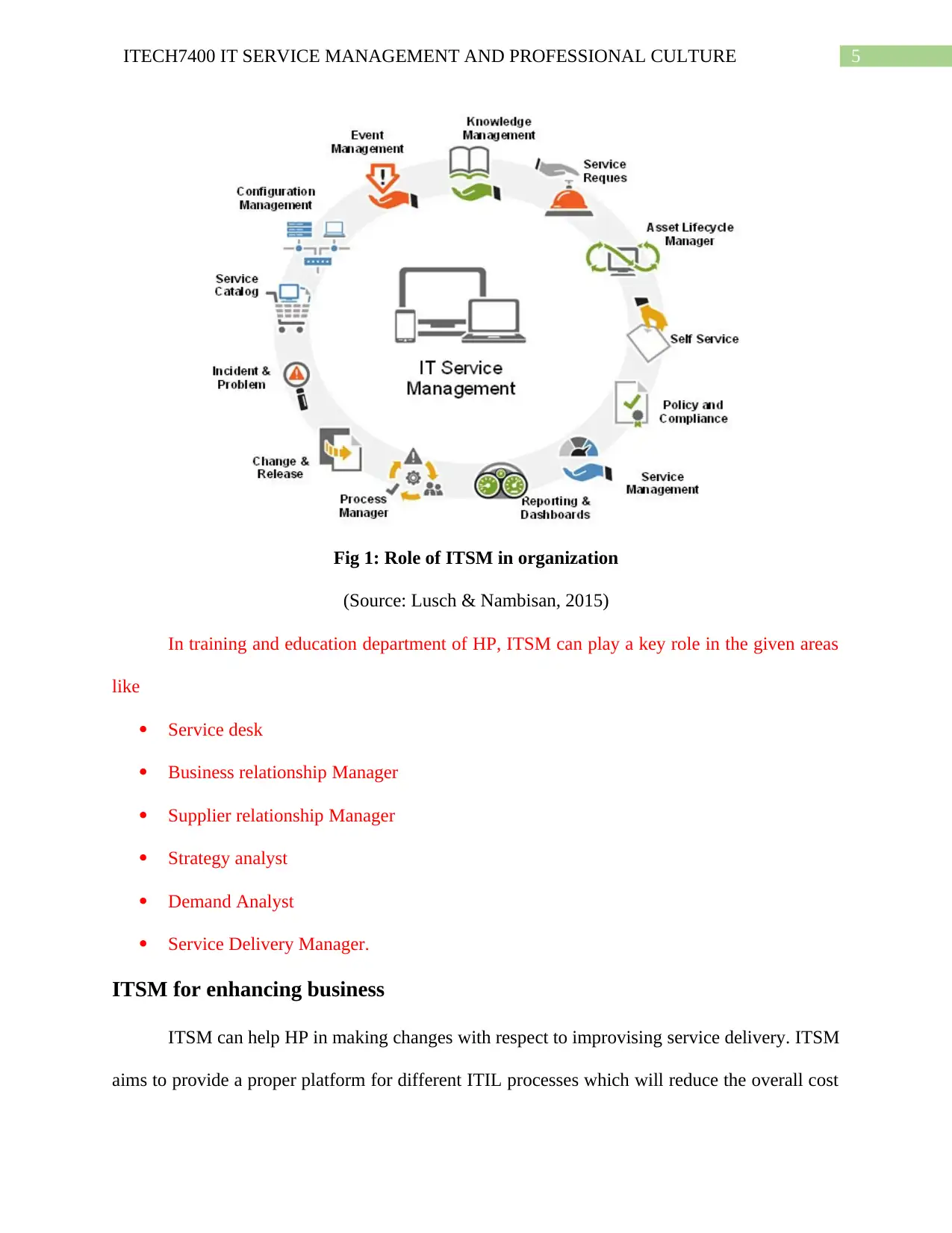
5ITECH7400 IT SERVICE MANAGEMENT AND PROFESSIONAL CULTURE
Fig 1: Role of ITSM in organization
(Source: Lusch & Nambisan, 2015)
In training and education department of HP, ITSM can play a key role in the given areas
like
Service desk
Business relationship Manager
Supplier relationship Manager
Strategy analyst
Demand Analyst
Service Delivery Manager.
ITSM for enhancing business
ITSM can help HP in making changes with respect to improvising service delivery. ITSM
aims to provide a proper platform for different ITIL processes which will reduce the overall cost
Fig 1: Role of ITSM in organization
(Source: Lusch & Nambisan, 2015)
In training and education department of HP, ITSM can play a key role in the given areas
like
Service desk
Business relationship Manager
Supplier relationship Manager
Strategy analyst
Demand Analyst
Service Delivery Manager.
ITSM for enhancing business
ITSM can help HP in making changes with respect to improvising service delivery. ITSM
aims to provide a proper platform for different ITIL processes which will reduce the overall cost
⊘ This is a preview!⊘
Do you want full access?
Subscribe today to unlock all pages.

Trusted by 1+ million students worldwide
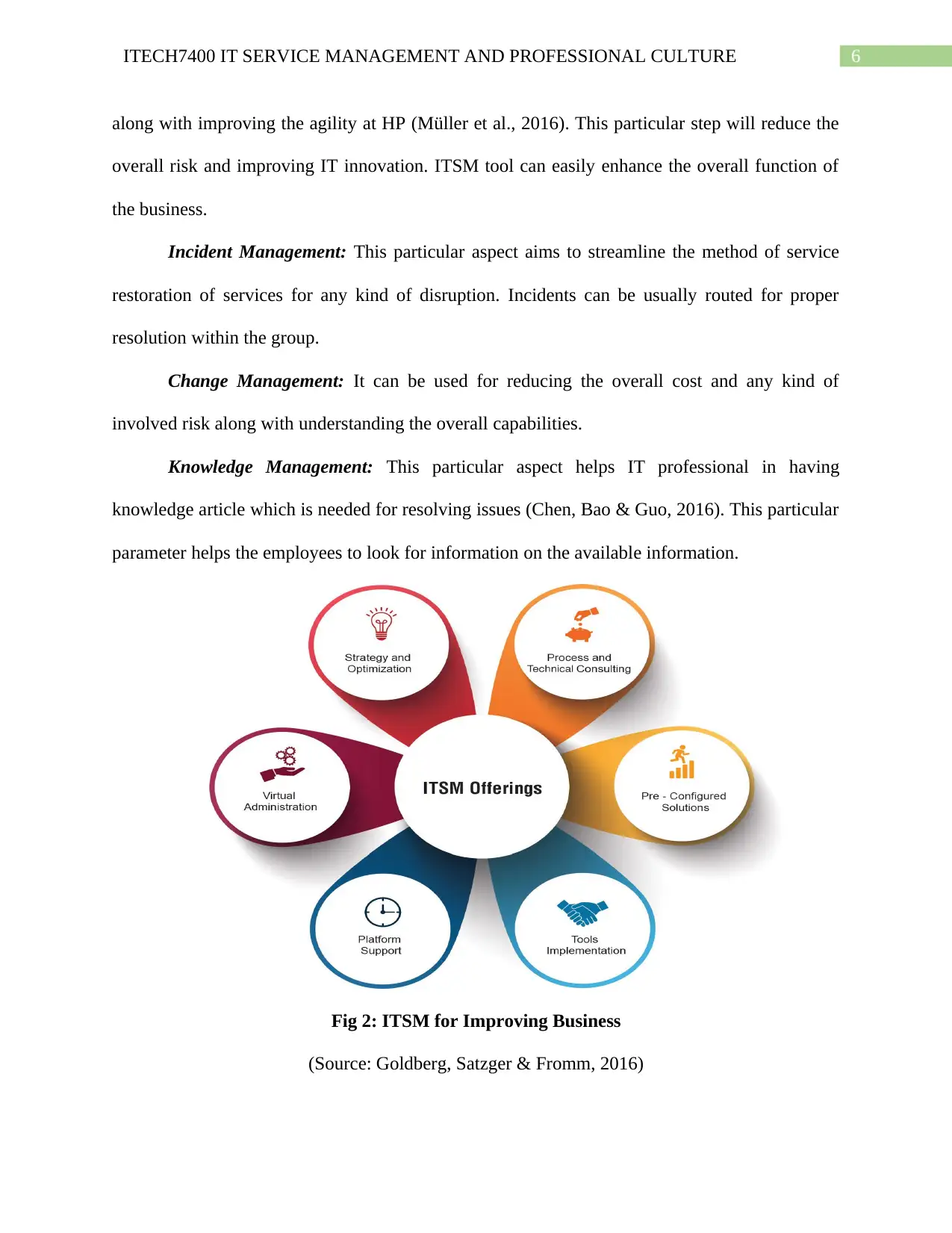
6ITECH7400 IT SERVICE MANAGEMENT AND PROFESSIONAL CULTURE
along with improving the agility at HP (Müller et al., 2016). This particular step will reduce the
overall risk and improving IT innovation. ITSM tool can easily enhance the overall function of
the business.
Incident Management: This particular aspect aims to streamline the method of service
restoration of services for any kind of disruption. Incidents can be usually routed for proper
resolution within the group.
Change Management: It can be used for reducing the overall cost and any kind of
involved risk along with understanding the overall capabilities.
Knowledge Management: This particular aspect helps IT professional in having
knowledge article which is needed for resolving issues (Chen, Bao & Guo, 2016). This particular
parameter helps the employees to look for information on the available information.
Fig 2: ITSM for Improving Business
(Source: Goldberg, Satzger & Fromm, 2016)
along with improving the agility at HP (Müller et al., 2016). This particular step will reduce the
overall risk and improving IT innovation. ITSM tool can easily enhance the overall function of
the business.
Incident Management: This particular aspect aims to streamline the method of service
restoration of services for any kind of disruption. Incidents can be usually routed for proper
resolution within the group.
Change Management: It can be used for reducing the overall cost and any kind of
involved risk along with understanding the overall capabilities.
Knowledge Management: This particular aspect helps IT professional in having
knowledge article which is needed for resolving issues (Chen, Bao & Guo, 2016). This particular
parameter helps the employees to look for information on the available information.
Fig 2: ITSM for Improving Business
(Source: Goldberg, Satzger & Fromm, 2016)
Paraphrase This Document
Need a fresh take? Get an instant paraphrase of this document with our AI Paraphraser
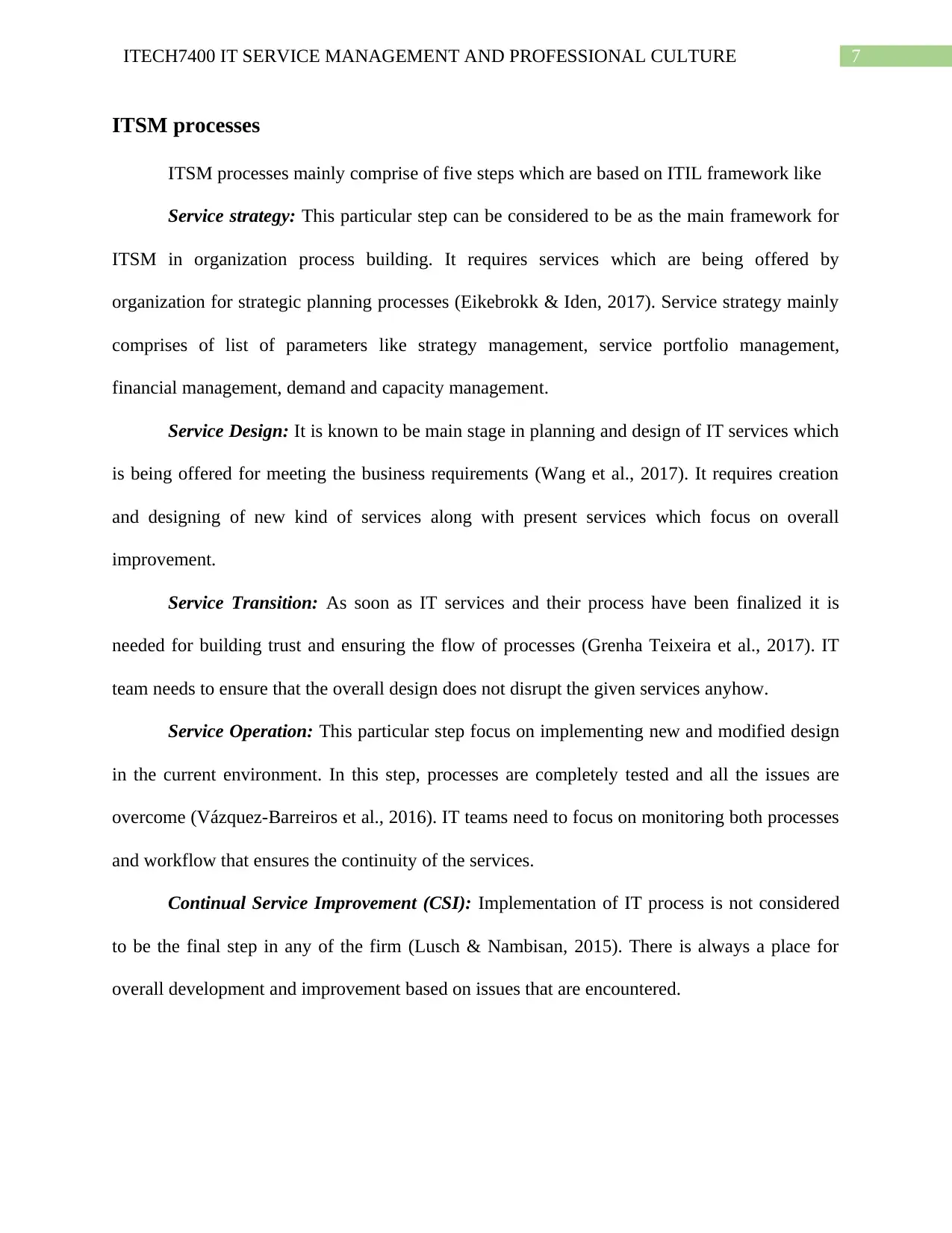
7ITECH7400 IT SERVICE MANAGEMENT AND PROFESSIONAL CULTURE
ITSM processes
ITSM processes mainly comprise of five steps which are based on ITIL framework like
Service strategy: This particular step can be considered to be as the main framework for
ITSM in organization process building. It requires services which are being offered by
organization for strategic planning processes (Eikebrokk & Iden, 2017). Service strategy mainly
comprises of list of parameters like strategy management, service portfolio management,
financial management, demand and capacity management.
Service Design: It is known to be main stage in planning and design of IT services which
is being offered for meeting the business requirements (Wang et al., 2017). It requires creation
and designing of new kind of services along with present services which focus on overall
improvement.
Service Transition: As soon as IT services and their process have been finalized it is
needed for building trust and ensuring the flow of processes (Grenha Teixeira et al., 2017). IT
team needs to ensure that the overall design does not disrupt the given services anyhow.
Service Operation: This particular step focus on implementing new and modified design
in the current environment. In this step, processes are completely tested and all the issues are
overcome (Vázquez-Barreiros et al., 2016). IT teams need to focus on monitoring both processes
and workflow that ensures the continuity of the services.
Continual Service Improvement (CSI): Implementation of IT process is not considered
to be the final step in any of the firm (Lusch & Nambisan, 2015). There is always a place for
overall development and improvement based on issues that are encountered.
ITSM processes
ITSM processes mainly comprise of five steps which are based on ITIL framework like
Service strategy: This particular step can be considered to be as the main framework for
ITSM in organization process building. It requires services which are being offered by
organization for strategic planning processes (Eikebrokk & Iden, 2017). Service strategy mainly
comprises of list of parameters like strategy management, service portfolio management,
financial management, demand and capacity management.
Service Design: It is known to be main stage in planning and design of IT services which
is being offered for meeting the business requirements (Wang et al., 2017). It requires creation
and designing of new kind of services along with present services which focus on overall
improvement.
Service Transition: As soon as IT services and their process have been finalized it is
needed for building trust and ensuring the flow of processes (Grenha Teixeira et al., 2017). IT
team needs to ensure that the overall design does not disrupt the given services anyhow.
Service Operation: This particular step focus on implementing new and modified design
in the current environment. In this step, processes are completely tested and all the issues are
overcome (Vázquez-Barreiros et al., 2016). IT teams need to focus on monitoring both processes
and workflow that ensures the continuity of the services.
Continual Service Improvement (CSI): Implementation of IT process is not considered
to be the final step in any of the firm (Lusch & Nambisan, 2015). There is always a place for
overall development and improvement based on issues that are encountered.
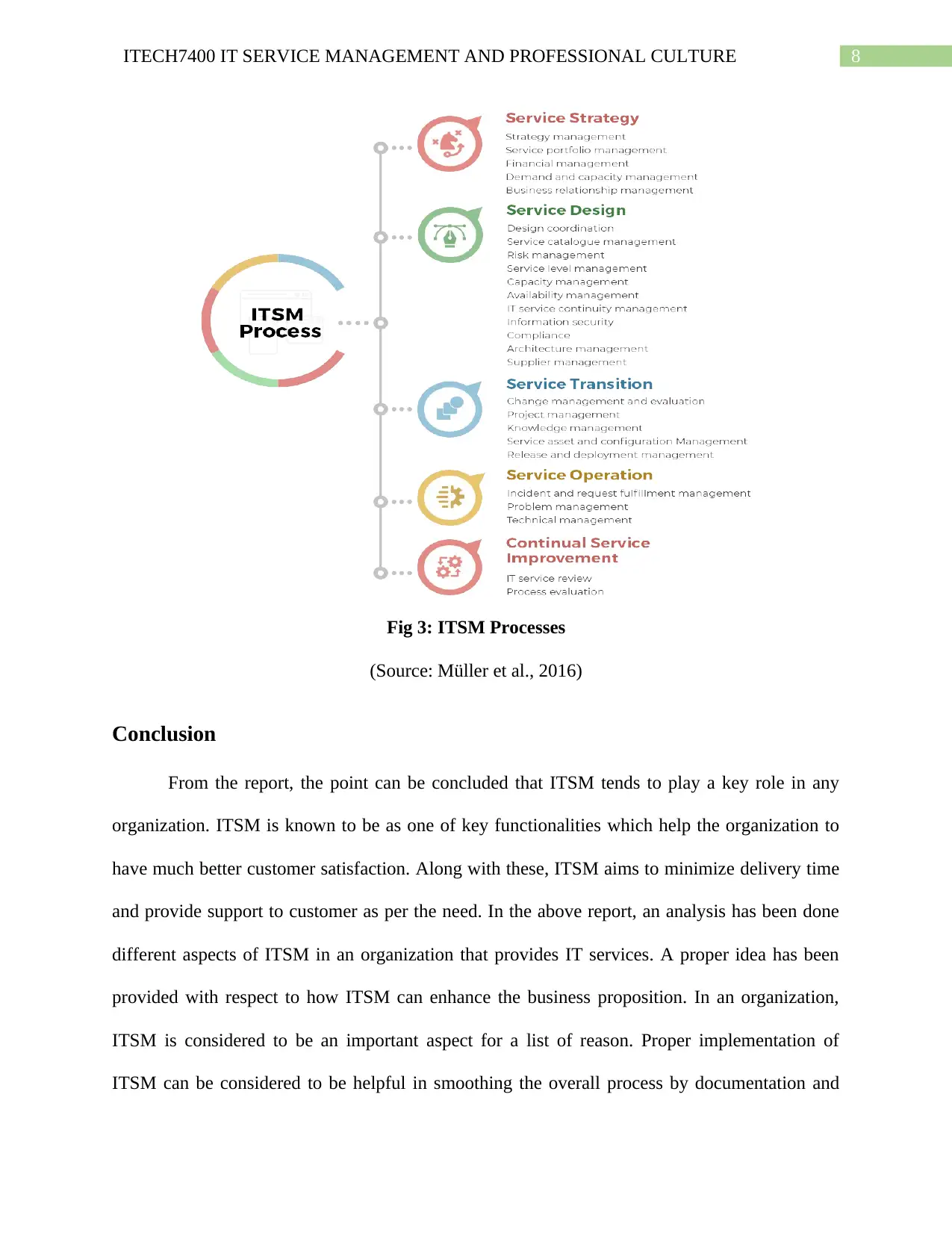
8ITECH7400 IT SERVICE MANAGEMENT AND PROFESSIONAL CULTURE
Fig 3: ITSM Processes
(Source: Müller et al., 2016)
Conclusion
From the report, the point can be concluded that ITSM tends to play a key role in any
organization. ITSM is known to be as one of key functionalities which help the organization to
have much better customer satisfaction. Along with these, ITSM aims to minimize delivery time
and provide support to customer as per the need. In the above report, an analysis has been done
different aspects of ITSM in an organization that provides IT services. A proper idea has been
provided with respect to how ITSM can enhance the business proposition. In an organization,
ITSM is considered to be an important aspect for a list of reason. Proper implementation of
ITSM can be considered to be helpful in smoothing the overall process by documentation and
Fig 3: ITSM Processes
(Source: Müller et al., 2016)
Conclusion
From the report, the point can be concluded that ITSM tends to play a key role in any
organization. ITSM is known to be as one of key functionalities which help the organization to
have much better customer satisfaction. Along with these, ITSM aims to minimize delivery time
and provide support to customer as per the need. In the above report, an analysis has been done
different aspects of ITSM in an organization that provides IT services. A proper idea has been
provided with respect to how ITSM can enhance the business proposition. In an organization,
ITSM is considered to be an important aspect for a list of reason. Proper implementation of
ITSM can be considered to be helpful in smoothing the overall process by documentation and
⊘ This is a preview!⊘
Do you want full access?
Subscribe today to unlock all pages.

Trusted by 1+ million students worldwide
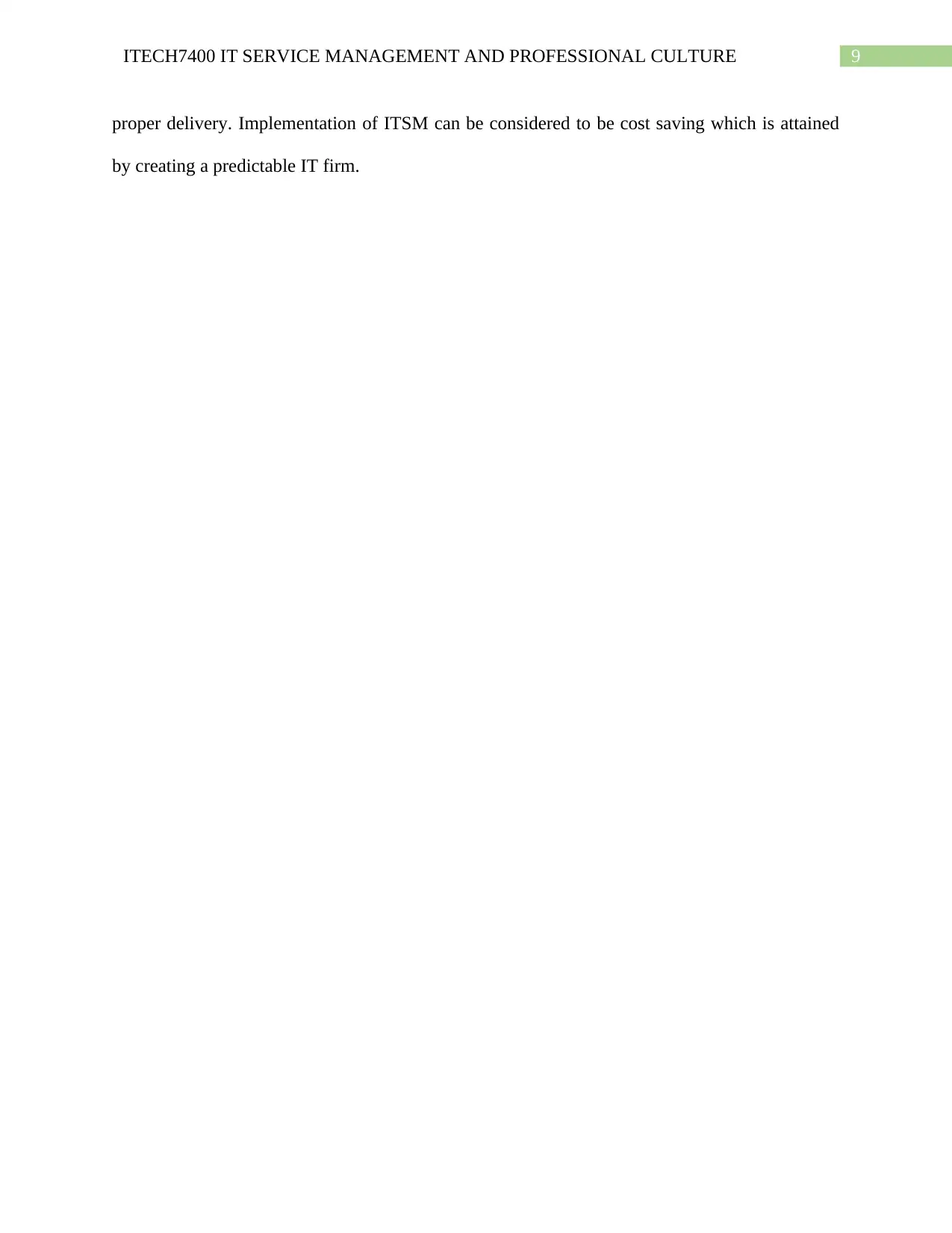
9ITECH7400 IT SERVICE MANAGEMENT AND PROFESSIONAL CULTURE
proper delivery. Implementation of ITSM can be considered to be cost saving which is attained
by creating a predictable IT firm.
proper delivery. Implementation of ITSM can be considered to be cost saving which is attained
by creating a predictable IT firm.
Paraphrase This Document
Need a fresh take? Get an instant paraphrase of this document with our AI Paraphraser
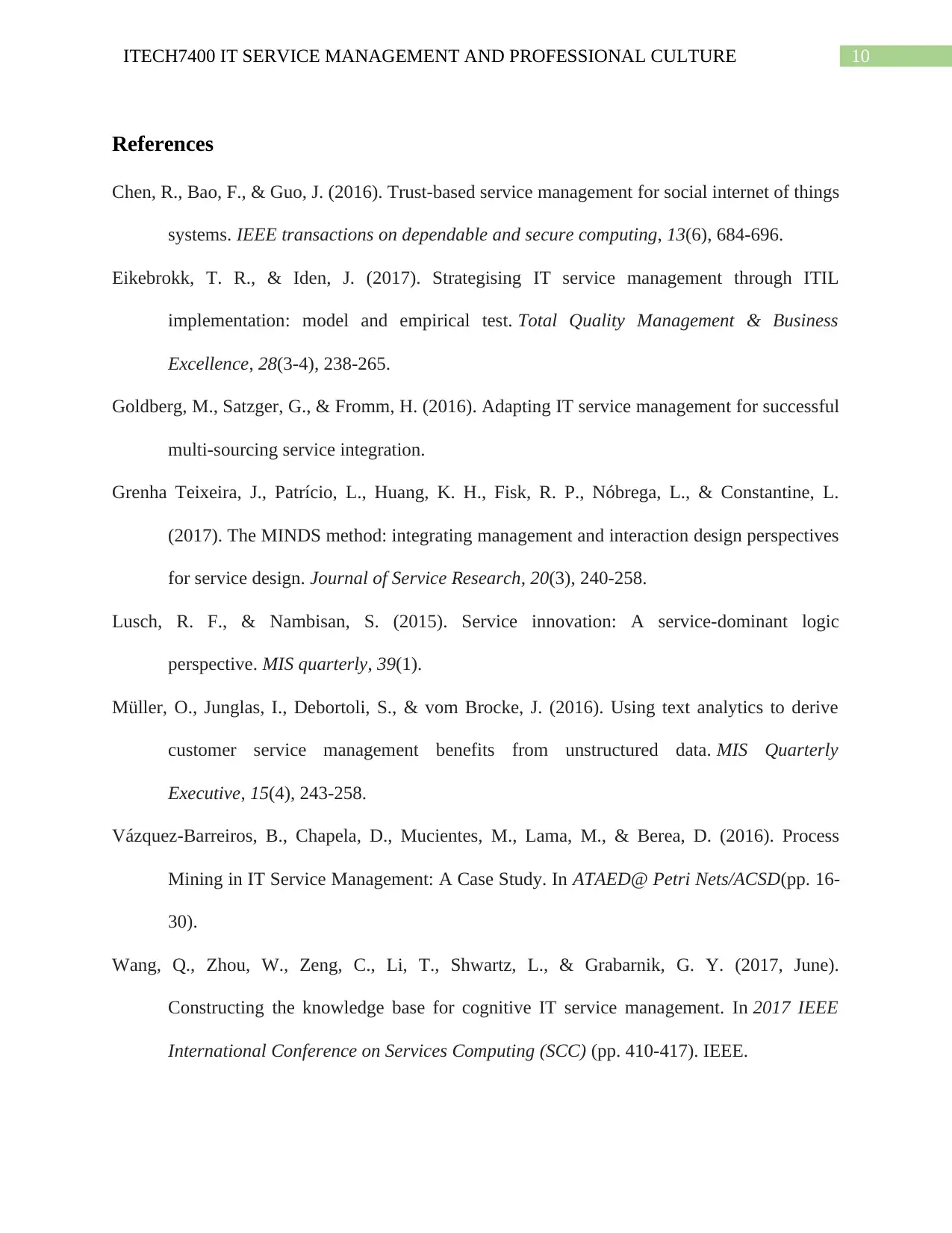
10ITECH7400 IT SERVICE MANAGEMENT AND PROFESSIONAL CULTURE
References
Chen, R., Bao, F., & Guo, J. (2016). Trust-based service management for social internet of things
systems. IEEE transactions on dependable and secure computing, 13(6), 684-696.
Eikebrokk, T. R., & Iden, J. (2017). Strategising IT service management through ITIL
implementation: model and empirical test. Total Quality Management & Business
Excellence, 28(3-4), 238-265.
Goldberg, M., Satzger, G., & Fromm, H. (2016). Adapting IT service management for successful
multi-sourcing service integration.
Grenha Teixeira, J., Patrício, L., Huang, K. H., Fisk, R. P., Nóbrega, L., & Constantine, L.
(2017). The MINDS method: integrating management and interaction design perspectives
for service design. Journal of Service Research, 20(3), 240-258.
Lusch, R. F., & Nambisan, S. (2015). Service innovation: A service-dominant logic
perspective. MIS quarterly, 39(1).
Müller, O., Junglas, I., Debortoli, S., & vom Brocke, J. (2016). Using text analytics to derive
customer service management benefits from unstructured data. MIS Quarterly
Executive, 15(4), 243-258.
Vázquez-Barreiros, B., Chapela, D., Mucientes, M., Lama, M., & Berea, D. (2016). Process
Mining in IT Service Management: A Case Study. In ATAED@ Petri Nets/ACSD(pp. 16-
30).
Wang, Q., Zhou, W., Zeng, C., Li, T., Shwartz, L., & Grabarnik, G. Y. (2017, June).
Constructing the knowledge base for cognitive IT service management. In 2017 IEEE
International Conference on Services Computing (SCC) (pp. 410-417). IEEE.
References
Chen, R., Bao, F., & Guo, J. (2016). Trust-based service management for social internet of things
systems. IEEE transactions on dependable and secure computing, 13(6), 684-696.
Eikebrokk, T. R., & Iden, J. (2017). Strategising IT service management through ITIL
implementation: model and empirical test. Total Quality Management & Business
Excellence, 28(3-4), 238-265.
Goldberg, M., Satzger, G., & Fromm, H. (2016). Adapting IT service management for successful
multi-sourcing service integration.
Grenha Teixeira, J., Patrício, L., Huang, K. H., Fisk, R. P., Nóbrega, L., & Constantine, L.
(2017). The MINDS method: integrating management and interaction design perspectives
for service design. Journal of Service Research, 20(3), 240-258.
Lusch, R. F., & Nambisan, S. (2015). Service innovation: A service-dominant logic
perspective. MIS quarterly, 39(1).
Müller, O., Junglas, I., Debortoli, S., & vom Brocke, J. (2016). Using text analytics to derive
customer service management benefits from unstructured data. MIS Quarterly
Executive, 15(4), 243-258.
Vázquez-Barreiros, B., Chapela, D., Mucientes, M., Lama, M., & Berea, D. (2016). Process
Mining in IT Service Management: A Case Study. In ATAED@ Petri Nets/ACSD(pp. 16-
30).
Wang, Q., Zhou, W., Zeng, C., Li, T., Shwartz, L., & Grabarnik, G. Y. (2017, June).
Constructing the knowledge base for cognitive IT service management. In 2017 IEEE
International Conference on Services Computing (SCC) (pp. 410-417). IEEE.
1 out of 11
Related Documents
Your All-in-One AI-Powered Toolkit for Academic Success.
+13062052269
info@desklib.com
Available 24*7 on WhatsApp / Email
![[object Object]](/_next/static/media/star-bottom.7253800d.svg)
Unlock your academic potential
Copyright © 2020–2025 A2Z Services. All Rights Reserved. Developed and managed by ZUCOL.





